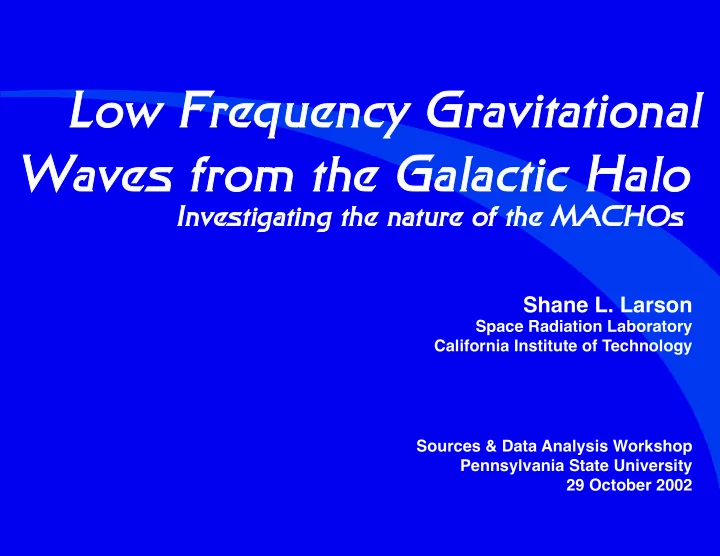

Low Frequency Gravitational Waves from the Galactic Halo Investigating the nature of the MACHOs Shane L. Larson Space Radiation Laboratory California Institute of Technology Sources & Data Analysis Workshop Pennsylvania State University 29 October 2002
THE STORYLINE • Recollection of microlensing • MACHOs and the dark halo (EM) • Gravitational waves from MACHOs � » High frequency � » Low frequency BH MACHOs � » Low frequency WD MACHOs • Questions
LENSING Apparent Postion Deflector True Mass Position Image 1 Lens q Mass Image 2 Lens
GRAVITATIONAL MICROLENSING • If the angular separation of the images is too small to be resolved microlensing occurs A B C • Microlensing amplifies the light; how much depends on the impact parameter with lens 4GM R E = EINSTEIN D amplification RADIUS C c 2 B A = u 2 + 2 AMPLIFICATION A u u 2 + 4 time
THE MACHO SEARCH • The MACHO Collaboration monitored 11.7 million stars in the Large Magellanic Cloud, on a regular basis, for 5.7 years • Detected 13-17 m lens events • MACHO mass: m ~ 0.5 M O . • Halo Fraction: ~8% – 50%, � depending on halo model • ~ 2 x 10 11 MACHOs out to � 50 kpc
MACHOs @ HIGH FREQUENCY • [1996] Nakamura, Sasaki, Tanaka & Thorne assume MACHOs � are primordial black holes, approximate a distribution to � estimate coalesence rate � » (50 kpc halo) ~ 5 x 108 binaries, ~ 5 x 10-2 yr-1 gx-1 � » (300 kpc halo) ~ 3 x 109 binaries, ~ 0.3 yr-1 gx-1 • Suggest LIGO I could detect these to 15 Mpc (Virgo), so � might see several per year • LIGO II could detect these to 150 Mpc, so could still see � several per year even if rate is 10-5 yr-1 gx-1 • [grqc/9609027 (OMNI-I)] Finn estimates 30% of MACHOS are � binaries • Coalesence rate: 15 yr-1 gx-1
HILS BENDER GALACTIC BACKGROUND -15 LISA -16 Hils-Bender Disk WD AM CVn Binaries (per ÷ Hz) -17 -18 log hf -19 -20 -21 -5 -4 -3 -2 -1 0 log f (Hz) Bender & Hils, CQG 14, 1439 (1997) Hils, Bender & Webbink, ApJ 360, 75 (1990)
BH MACHOs at LOW FREQUENCY • Ioka et al. [2000] considered extracting galactic halo � structure from BH MACHOs with LISA: core radius, � triaxiality etc to within ~10% • Catch: 700 individual binaries, 10 yrs of observations • [1998] Hiscock assumed the NSTT binary distribution � function and evolved to present time • Generates the distribution in the current epoch � evolving only under gravitational radiation • Analysis by Ioka et al. [1999] obtain similar spectra
BH MACHO GALACTIC HALO -15 LISA bh Halo ( W h2 = 0.1) -16 bh Halo ( W h2 = 1.0) (per ÷ Hz) -17 -18 log hf -19 -20 -21 -5 -4 -3 -2 -1 0 log f (Hz) Hiscock, ApJ 509, L101 (1998) Ioka et al, PRD 60, 083512 (1999)
WHITE DWARF MACHOs? • For a long time, WD had been discounted as halo � objects — searches for dim red stars found none • Recent cooling models ( Hansen, ApJ, 520, 680 [1999] ; Saumon & Jacobson, ApJ, 511, L107[1999] ) suggest WD form molecular � � hydrogen atmospheres, absorb red light • New observing campaigns have turned up WD � halo candidates ( Ibata et al, ApJ, 524, L95 [1999] ; Ibata et al, ApJ, 532, L41 [2000] ; Oppenheimer et al, Science, 292, 698 [2001] ) � • Operate on assumption that there are WD in halo. � Simplest assumption possible: mimic the disk.
Scaling the Disk to the Halo • Simply take the disk distribution and mulitply by � a scaling function: h a l o d i s k hf = K( a ) hf 1/2 [ N halo · d -2 Ò halo ] K( a ) = a N disk · d -2 Ò disk • N and · d -2 Ò can be computed from distributions • Key unknown parameter is a : a = fraction of WD in binaries in halo fraction of WD in binaries in disk
Binary Fraction Ratio: a • When a = 1, the WD binary fraction is equal in the halo � and the disk, and the scale factor is K(1) = 5.42� � � 50 kpc halo K(1) = 5.49� � � 300 kpc halo • When the scale factor K( a ) > 1, halo is brighter than disk a > 10 -2 � � � � 50 kpc halo a > 5 x 10 -3 � � 300 kpc halo • If small relative fractions of halo WD are binary (~1%), � the halo will stand out from the disk
WHITE DWARF GALACTIC HALO -15 LISA -16 wd Halo (50 kpc) wd Halo (300 kpc) (per ÷ Hz) -17 -18 log hf -19 -20 -21 -5 -4 -3 -2 -1 0 log f (Hz) Hiscock, Larson, Routzahn & Kulick, ApJ 540, L5 (2000)
What now? • The real outstanding questions about the halo: � » What's the other 50%? � » What in the blazes are the MACHOs? • What about GW from the halo? � » BH — is there a better distribution? � » WD — is there a better distribution? � » Other Exotics — boson stars? • EM astronomy undoubtedly has more to say � » Deep halo observing campaign? � » Can it be done from archival data?
Recommend
More recommend